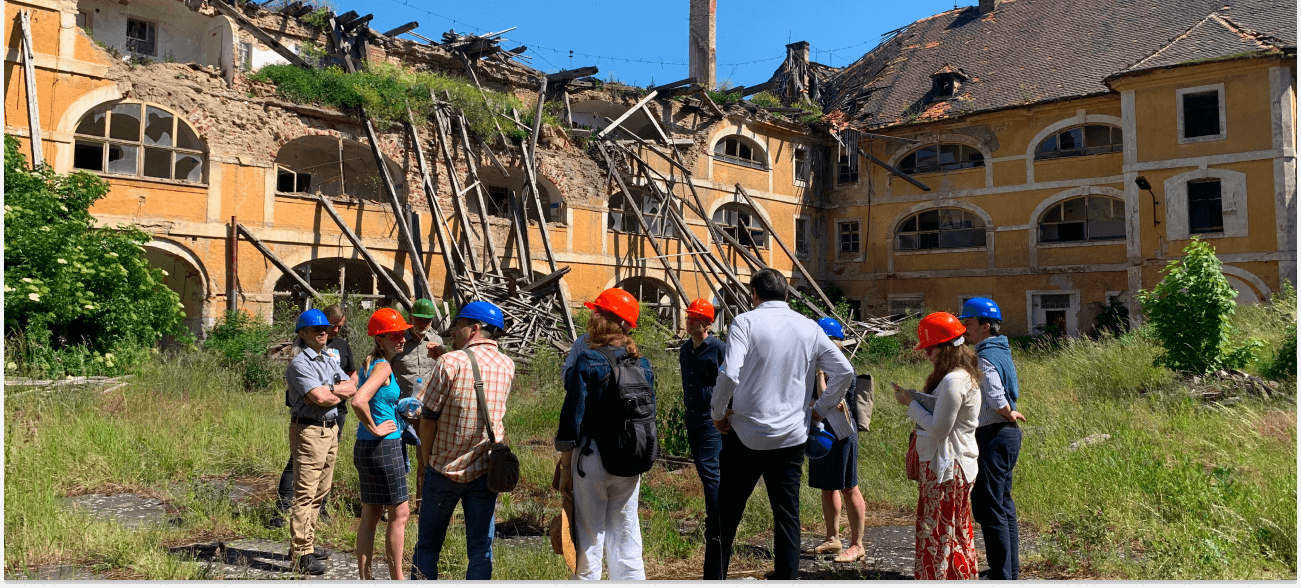
International Memorial Museums Charter
The International Memorial Museums Charter provides memorial museums with internationally agreed-upon principles and ethics for commemorating the victims of the Holocaust, helping to avoid the politicization or nationalization of their memory. It was first adopted by the IHRA Plenary, its decision-making body made up of all its Member Countries, in 2012 with an addendum adopted in 2016.
Introduction to the international memorial museums charter
Memorial museums are responsible to protect the dignity of the victims from all forms of exploitation and to ensure, beyond conventional history lessons, that the interpretation of political events inspires critical, independent thinking about the past.
This is why it is time that the memorial museums, as a unique form of contemporary history museums, should reach an understanding for cooperation with each other on a national and international level.
An organizational framework needed for an international consortium has already been created.
The mission of the International Holocaust Remembrance Alliance is to support institutions that commemorate Nazi-victims and support the preservation of the historic sites, sources, and artefacts in the spirit and purpose of the Stockholm Declaration.
The mission of the International Committee of Memorial Museums (IC MEMO) through its integration into the International Council of Museums (ICOM) honoring the UN Charter’s universal ethical and political principles, is to universal human and civil rights and the careful preservation of cultural assets. The IC MEMO functions as an umbrella organization for many very different memorial museums located in Europe, Africa, America and Asia that are dedicated to victims of state tyranny.
The international memorial museums charter (adopted 2012)
This is an international memorial museums charter that is oriented both towards the UN declaration of Human Rights and the ethical principles of ICOM. General principles of commemoration in memorial museums are:
1. A joint culture of remembrance cannot and must not be dictated by decree. Given the very different historical experiences, memorial museums should accept the co-existence of different commemorative imperatives that are aimed at pluralistic cultures of remembrance. Institutions should be designed for cooperation instead of encouraging competition which can create a struggle for dominance. Should this be a practical venture, a joint culture of remembrance could develop gradually out of a multitude of decentralized initiatives.
2. A pluralistic culture of remembrance also requires a shared set of positive values. These already exist in the universal declaration of human and civil rights.
3. Memorial museums as contemporary history museums are involved mostly in remembering public crimes committed against minorities. This is why current states, governments, and local communities bear a great responsibility to memorial museums and should safeguard their collections and assure them the highest degree of independence from political directives. At the same time the memorial museums have to anchor themselves broadly within civil society and make a special effort to integrate minorities.
4. Modern memorial museums are contemporary history museums with a special obligation to humanitarian and civic education. The memorial museums will only be able to assert themselves against political interests and lobbyists if they have achieved a high level of quality work, infrastructure, and personal organization.
5. Fundamental decisions in the memorial museums concerning content, education and design should be made mostly on the basis of an open, non-hierarchical pluralistic discussion with survivors, scholars, educators, lobbyists, and committed social groups. The work of memorial museums is principally science based. State-run institutions and private sponsors have to accept this.
6. Information conveyed in exhibitions, publications and educational projects about historical events should evoke empathy with the victims as individual humans and groups which were specifically targeted for persecution. Interpretation should avoid commemoration in the form of revenge, hate and resentments between different groups of victims.
7. Historical experiences have to be integrated into historical contexts without minimizing the personal suffering of individuals. The integration of historical events should take place on the level of modern contemporary historical research and honor the scholarly principles of discourse and multiple perspectives.
8. The perspective of the perpetrators who committed the crimes has to be addressed. The perpetrators should not be demonized, but rather their ideology, aims and motives should be used to explain their actions. This includes the institutional and social mechanism as well as the individual biographies of perpetrators. The ability to question one’s own perspective also takes into account the inclusion of one’s own crimes and self-images into the presentation of the “other.” The broad and very diverse group of bystanders should be handled in the same manner.
9. Memorial museums located at historically authentic sites where crimes were committed provide an immense opportunity for conducting historical and civic education, but there are also big risks involved. This is why memorial museums need to orient their educational work less towards an agreement about the content and more towards universal principles. These demand that the visitors are not overwhelmed or indoctrinated, that the subjective view of individuals be respected, and that controversial subjects be treated as controversial.
10. Memorial museums as contemporary history museums are always engaged in self-criticism of their own history, and have to embed it in a history of their respective remembrance culture. Cognizant of current trends of thinking, they should gear their presentations towards current interpretations of the past, while being anchored to the actual historical events.
Addendum to the international memorial museums charter: Criteria for adequate memorial sites (adopted 2016)
Bearing in mind that memorial sites often differ considerably from each other in various aspects some criteria listed below should have validity for all. From the point of view of the Committee on the Genocide of the Roma and the Museum Memorial Working Group these would be, based on the International Memorial Museums Charter, as adopted by the ITF Plenary in Liège in 2012:
Ethical decency, paying tribute to the victims
Memorial museums are responsible to protect the dignity of the victims from all forms of exploitation and to ensure, beyond conventional history lessons, that the interpretation of political events inspires critical, independent thinking about the past.
Clear responsibility for a site must be defined (local, provincial, state); independence of sites from political directives
Memorial museums as contemporary history museums are involved mostly in remembering public crimes committed against minorities. This is why current states, governments, and local communities bear a great responsibility to memorial museums and should safeguard their collections and assure them the highest degree of independence from political directives. At the same time the memorial museums have to anchor themselves broadly within civil society and make a special effort to integrate minorities.
Modern memorial museums are contemporary history museums with a special obligation to humanitarian and civic education. The memorial museums will only be able to assert themselves against political interests and lobbyists if they have achieved a high level of quality work, infrastructure, and personal organization.
Inclusion of and consultation with inter alia victim associations in the design and content of the site; pluralistic discussions; science-based work
Fundamental decisions in the memorial museums concerning content, education and design should be made mostly on the basis of an open, non-hierarchical pluralistic discussion with survivors, scholars, educators, lobbyists, and committed social groups. The work of memorial museums is principally science based. State-run institutions and private sponsors have to accept this.
Given the progressing age of members of victim associations it should be considered to include successively in the advisory boards also committed new associations from younger civil society.
Adequate information on-site
Information conveyed in exhibitions, publications and educational projects about historical events should evoke empathy with the victims as individual humans and groups which were specifically targeted for persecution. Interpretation should avoid commemoration in the form of revenge, hate and resentments between different groups of victims.
The perspective of the perpetrators who committed the crimes has to be addressed. The perpetrators should not be demonized, but rather their ideology, aims and motives should be used to explain their actions. This includes the institutional and social mechanism as well as the individual biographies of perpetrators. The ability to question one’s own perspective also takes into account the inclusion of one’s own crimes and self-images into the presentation of the “other.” The broad and very diverse group of bystanders should be handled in the same manner.
Pedagogical offers for guided tours, pedagogical materials and sufficient accessibility to these offers/materials
Memorial museums located at historically authentic sites where crimes were committed provide an immense opportunity for conducting historical and civic education, but there are also big risks involved. This is why memorial museums need to orient their educational work less towards an agreement about the content and more towards universal principles. These demand that the visitors are not overwhelmed or indoctrinated, that the subjective view of individuals be respected, and that controversial subjects be treated as controversial.
Teacher-training offers should be provided in order to prepare adequately visits of school classes and their debriefing after the visit; pedagogical materials should be made available online.
Memorial Museums should also provide adequate information and guided tours for the growing number of individual visitors according to their fields of interest and to their commemorative needs, including multilingual programs.
Physical accessibility must be ensured (public transport), barrier-free accession made available, if possible
It is of utmost importance that memorial sites should be accessible by public transport. It is unacceptable that important memorial sites can only be reached with difficulties and by private means. Barrier-free accession to a site should have priority over e.g. heritage protection laws.
Adequate level of heritage protection (preferably of national importance) is ensured
Adequate level of protection (preferably on the national level) is ensured through active and effective legislative and physical measures preserving, safeguarding and developing the site for the benefit of present and future generations.
Sign up to our newsletter to
receive the latest updates
By signing up to the IHRA newsletter, you agree to our Privacy Policy


